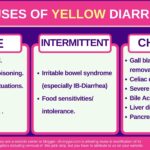7 Celiac disease Stool changes (With Poop Color and Form Picture Chart)
Our content is not intended nor recommended as a substitute for medical advice by your doctor. Use for informational purposes only.
Stool changes with celiac disease are one of the most common symptoms.
Diarrhea with light brown, yellowish, or gray poop is frequently found with celiac disease; the stool is often offensive and floats on the toilet.
However, not all patients with celiac disease have stool changes.
Today, we will discuss (in-depth) all the possible poop changes in patients with celiac disease.
Possible stool changes with celiac disease include:
- Pale (light brown, yellowish, or greyish).
- Loose or watery poop.
- Greasy (oily).
- Foul-smelling.
- Bulky.
- Floating.
- Less frequent: constipation (hard stool).
1. Pale poop color (light brown, yellow, or grey stool).
With celiac disease, your small intestine gets inflamed as an allergic reaction to gluten. Gluten is a protein found in wheat, rye, and barley.
The inflammation eventually leads to a loss in the ability of your small intestine to absorb nutrients.
The unabsorbed food (particularly fat) passes through the intestine. As a result, the digestive system becomes loaded with unabsorbed food, which results in diarrhea and high-fat stool.
Celiac disease stool color becomes light brown, yellow, or greyish by:
- The speeding up of intestinal contents (the unabsorbed foods): this acceleration of food passage won’t allow enough time for the stool to be processed into its standard brown color.
- The presence of more fat in your stool (fat is yellowish).
Suspect celiac disease whenever your stool becomes persistently yellowish or greyish (often combined with diarrhea).
The stool color changes are a result of food malabsorption. So, once you start the treatment of celiac disease by following a STRICT gluten-free diet, your stool should revert to its standard brown color.
Also, remember that all shades of brown are considered normal (light or dark brown). Also, food may cause occasional stool color changes while on a gluten-free diet.
For example:
- Green leafy vegetables (such as spinach) and green food colorings may lead to temporary greenish color.
- Sweet potatoes and other yellow pigments in food may cause temporary yellowish stool.
So, a temporary change in your stool color usually indicates one of two things:
- Non-compliance to a gluten-free diet.
- Food-related variation of stool color.
When stool color is associated with other symptoms of celiac disease (such as flatulence, distension, and diarrhea), it often means you’re not on a 100% gluten-free diet.
Isolated, transient stool color changes without diarrhea or other symptoms are often due to food factors.
So, don’t overthink every stool change if you have celiac disease on a gluten-free diet. Instead, seek medical help only for stool color changes associated with the recurrence of other symptoms of celiac disease.
The picture chart below shows the common celiac disease poop color changes.
2. Loose or watery consistency.
Diarrhea (watery or loose frequent bowel motion) is one of the most common symptoms of celiac disease. Up to 85% of people with undiagnosed celiac disease have chronic loose or watery stool (reference).
Fat malabsorption is the most important factor in celiac disease-related diarrhea. The unabsorbed fat reaches your colon (large intestine) in excess amounts.
The bacteria inside your colon break it down into fatty acids. Excess fatty acids cause loose stool or diarrhea by drawing water into the colon.
To determine the stool form, we use a stool scale called (the Bristol stool scale).
The stool chart below determines all the different types of stools and their prevalence in celiac disease:
All stool forms can occur with celiac disease. However, the most common types are types 6 and 7 in the Bristol stool scale.
However, not every loose stool or diarrhea is considered a celiac disease. In addition, other symptoms and risk factors of celiac disease increase the odds of loose stool being a sign of the disease.
Chronic diarrhea and loose stools are signs of more common diseases such as lactose intolerance and irritable bowel syndrome.
3. Greasy (oily) stools or steatorrhea.
If you have celiac disease, you’ll have difficulty digesting fats. This is because the unabsorbed fat accumulates in your digestive system.
Excess fat is the cause of diarrhea or loose stool due to the production of excess fatty acids inside the colon (which causes osmotic diarrhea).
Moreover, unchanged fat may appear in the stool with a greasy or oily nature. The condition is called (steatorrhea).
4. Foul-smelling
Celiac disease is a form of malabsorption syndrome. With malabsorption, excess food and nutrients stay inside your digestive system.
The bacteria act on these undigested and unabsorbed food contents to produce excess foul-smelling gas.
The onset of celiac disease is often associated with a persistent change in the stool odor. As a result, your poop becomes extremely foul-smelling compared to before.
After starting a gluten-free diet, the stool odor dramatically improves and may return to normal.
The foul smell of the stool may pass through periods of exacerbation depending on the types and the number of foods you eat.
Also, note that a temporary foul-smelling loose stool for a few days or weeks is often a sign of infection. Celiac disease causes PERSISTENT foul-smelling stools.
5. Bulkier stool.
Another sign of celiac disease is the increased stool volume per motion.
The malabsorbed foods often form a bulk leading to excess amounts of stool every time your go to the toilet.
They are often more noticeable when there is no watery diarrhea. Instead, a bulky, semi-formed, foul-smelling bowel motion for several weeks or months should raise suspicion about celiac disease.
People who eat more significant food often experience bulkier stool with celiac disease.
6. Floating in the toilet.
Floating means your stool contains micro air bubbles making it less dense than water. High fat in the stools also helps poop float, preventing stools from being soaked by water.
It is a widespread stool change with celiac disease due to excess gas production.
Although typical, floating poop is not specific to celiac disease. Any condition that causes excess gas in your digestive system may lead to floating stools.
Common examples include:
- Lactose intolerance.
- Irritable bowel syndrome.
- Eating too many gassy foods.
- Inflammatory bowel disease.
7. Less frequently, normal stools or constipation.
Not all cases of celiac disease have diarrhea or loose stool. Only 45% to 85% of patients with celiac disease have loose stool or diarrhea.
The remainder may have regular bowel movements (with minimal digestive symptoms). Even more, some may have constipation with celiac disease.
Several research studies found that people with celiac disease may have chronic constipation (reference1, reference2).
In such a case, the classic stool changes with celiac disease, such as loose stool, yellow color, foul smell, and floating, are often absent. Patients with atypical celiac disease symptoms often have delayed diagnosis.
BONUS 1: Mimics of celiac disease stool.
All cases of fat malabsorption may produce stool changes similar in color and characteristics to celiac disease stool.
Your doctor often excludes these causes during the workup for diagnosing celiac disease.
Common mimics of celiac disease stool (greasy, foul-smelling, loose stools):
- Chronic pancreatitis (exocrine pancreatic insufficiency).
- Lactose intolerance.
- Cystic fibrosis.
- Whipple’s disease.
- Crohn’s disease.
- And others.
BONUS 2: How are celiac disease stool changes treated?
The celiac disease treatment is simple, stop eating gluten, and everything will return to normal (including your stool).
So, a completely gluten-free diet is the definitive treatment for celiac disease stool changes such as diarrhea, color change, and the foul-smell.
Your doctor or dietitian often does a good job explaining what a gluten-free diet is. The main foods to avoid are wheat (or any wheat-containing foods), rye, and barley.
Learn More about the gluten-free diet.
- Evidence-based
- Written by a doctor.






